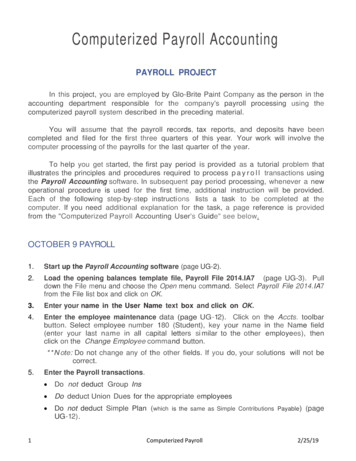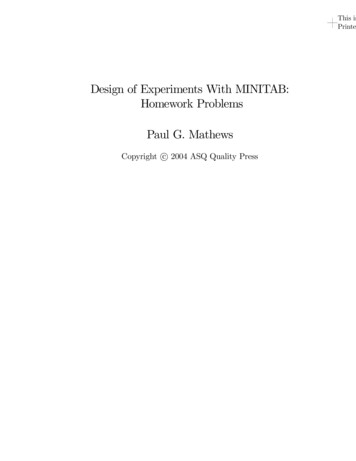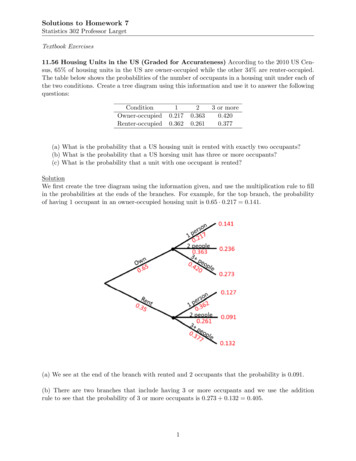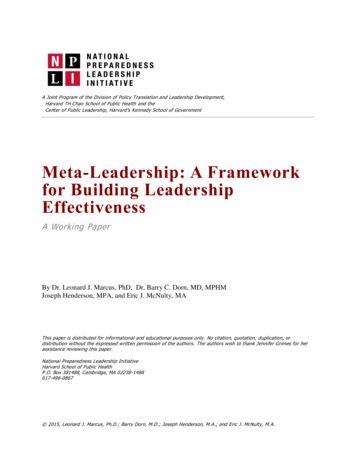
Transcription
LeadershipSeventh Edition
To Laurel, Lisa, Madison, Scott, and Kallie
LeadershipTheory and Practice Seventh EditionPeter g.NorthouseWestern Michigan University
For information:Copyright 2016 by SAGE Publications, Inc.SAGE Publications, Inc.All rights reserved. No part of this book may be reproducedor utilized in any form or by any means, electronic ormechanical, including photocopying, recording, or by anyinformation storage and retrieval system, without permissionin writing from the publisher.2455 Teller RoadThousand Oaks, California 91320E-mail: order@sagepub.comSAGE Publications Ltd.1 Oliver’s Yard55 City RoadLondon EC1Y 1SPPrinted in the United States of AmericaUnited KingdomLibrary of Congress Cataloging-in-Publication DataSAGE Publications India Pvt. Ltd.Northouse, Peter Guy.B 1/I 1 Mohan Cooperative Industrial AreaMathura Road, New Delhi 110 044IndiaSAGE Publications Asia-Pacific Pte. Ltd.3 Church Street#10-04 Samsung HubSingapore 049483Leadershop : theory and practice/Peter Northouse,Western Michigan University.—Seventh Edition.pages cmIncludes bibliographical references and index.ISBN 978-1-4833-1753-3 (pbk. : alk. paper)1. Leadership. 2. Leadership—Case studies. I. Title.HM1261.N67 s Editor: Maggie StanleyThis book is printed on acid-free paper.Associate Editor: Abbie RickardEditorial Assistant: Nicole MangonaProduction Editor: Libby LarsonCopy Editor: Melinda MassonTypesetter: C&M Digitals (P) Ltd.Proofreader: Sally JaskoldIndexer: Sheila BodellCover Designer: Gail BuschmanMarketing Manager: Liz ThorntonDigital Content Editor: Katie Bierach15 16 17 18 19 10 9 8 7 6 5 4 3 2 1
Brief ContentsPreface1. Introductionxvii12. Trait Approach194. Behavioral Approach713. Skills Approach5. Situational Approach43936. Path–Goal Theory1158. Transformational Leadership1617. Leader–Member Exchange Theory9. Authentic Leadership10. Servant Leadership11. Adaptive Leadership12. Psychodynamic Approach13. Leadership Ethics14. Team Leadership15. Gender and Leadership16. Culture and Leadership137195225257295329363397427Author Index467About the Author491Subject indexAbout the Contributors477493
Detailed ContentsPrefacexvii1. IntroductionLeadership DefinedWays of Conceptualizing LeadershipDefinition and ComponentsLeadership DescribedTrait Versus Process LeadershipAssigned Versus Emergent LeadershipLeadership and PowerLeadership and CoercionLeadership and ManagementPlan of the BookSummaryReferences12567781012131516172. Trait rminationIntegritySociabilityFive-Factor Personality Model and LeadershipEmotional IntelligenceHow Does the Trait Approach Work?StrengthsCriticisms191923242425262627293030
ApplicationCase StudiesCase 2.1 Choosing a New Director of ResearchCase 2.2 A Remarkable TurnaroundCase 2.3 Recruiting for the BankLeadership InstrumentLeadership Trait Questionnaire (LTQ)SummaryReferences3232333436373840413. Skills ApproachDescriptionThree-Skill ApproachTechnical SkillHuman SkillConceptual SkillSummary of the Three-Skill ApproachSkills ModelCompetenciesIndividual AttributesLeadership OutcomesCareer ExperiencesEnvironmental InfluencesSummary of the Skills ModelHow Does the Skills Approach Work?StrengthsCriticismsApplicationCase StudiesCase 3.1 A Strained Research TeamCase 3.2 A Shift for Lieutenant Colonel AdamsCase 3.3 Andy’s RecipeLeadership InstrumentSkills 55565657585960606264666769704. Behavioral ApproachDescriptionThe Ohio State StudiesThe University of Michigan StudiesBlake and Mouton’s Managerial (Leadership) GridAuthority–Compliance (9,1)717172737475
Country-Club Management (1,9)Impoverished Management (1,1)Middle-of-the-Road Management (5,5)Team Management (9,9)Paternalism/MaternalismOpportunismHow Does the Behavioral Approach Work?StrengthsCriticismsApplicationCase StudiesCase 4.1 A Drill Sergeant at FirstCase 4.2 Eating Lunch Standing UpCase 4.3 We Are FamilyLeadership InstrumentLeadership Behavior 82838485878890915. Situational ApproachDescriptionLeadership StylesDevelopment LevelsHow Does the Situational Approach Work?StrengthsCriticismsApplicationCase StudiesCase 5.1 Marathon Runners at Different LevelsCase 5.2 Why Aren’t They Listening?Case 5.3 Getting the Message AcrossLeadership InstrumentSituational Leadership Questionnaire: Sample 71081091121136. Path–Goal TheoryDescriptionLeader BehaviorsDirective LeadershipSupportive LeadershipParticipative LeadershipAchievement-Oriented Leadership115115117117117118118
Follower CharacteristicsTask CharacteristicsHow Does Path–Goal Theory Work?StrengthsCriticismsApplicationCase StudiesCase 6.1 Three Shifts, Three SupervisorsCase 6.2 Direction for Some, Support for OthersCase 6.3 Playing in the OrchestraLeadership InstrumentPath–Goal Leadership 51261281291321331351367. Leader–Member Exchange TheoryDescriptionEarly StudiesLater StudiesLeadership MakingHow Does LMX Theory Work?StrengthsCriticismsApplicationCase StudiesCase 7.1 His Team Gets the Best AssignmentsCase 7.2 Working Hard at Being FairCase 7.3 Taking on Additional ResponsibilitiesLeadership InstrumentLMX 7 51461481491501511521541551571588. Transformational LeadershipDescriptionTransformational Leadership DefinedTransformational Leadership and CharismaA Model of Transformational LeadershipTransformational Leadership FactorsTransactional Leadership FactorsNonleadership FactorOther Transformational PerspectivesBennis and NanusKouzes and Posner161161162164166167171172172172174
How Does the Transformational Approach Work?StrengthsCriticismsApplicationCase StudiesCase 8.1 The Vision FailedCase 8.2 An Exploration in LeadershipCase 8.3 Her Vision of a Model Research CenterLeadership 51871901919. Authentic LeadershipDescriptionAuthentic Leadership DefinedApproaches to Authentic LeadershipPractical ApproachTheoretical ApproachHow Does Authentic Leadership Work?StrengthsCriticismsApplicationsCase StudiesCase 9.1 Am I Really a Leader?Case 9.2 A Leader Under FireCase 9.3 The Reluctant First LadyLeadership InstrumentAuthentic Leadership Self-Assessment 520620720820921021221421721822022110. Servant LeadershipDescriptionServant Leadership DefinedHistorical Basis of Servant LeadershipTen Characteristics of a Servant LeaderBuilding a Theory About Servant LeadershipModel of Servant LeadershipAntecedent ConditionsServant Leader BehaviorsOutcomesSummary of the Model of Servant LeadershipHow Does Servant Leadership 239
CriticismsApplicationCase StudiesCase 10.1 Everyone Loves Mrs. NobleCase 10.2 Doctor to the PoorCase 10.3 Servant Leadership Takes FlightLeadership InstrumentServant Leadership 925025325411. Adaptive LeadershipDescriptionAdaptive Leadership DefinedA Model of Adaptive LeadershipSituational ChallengesLeader BehaviorsAdaptive WorkHow Does Adaptive Leadership Work?StrengthsCriticismsApplicationCase StudiesCase 11.1 Silence, Stigma, andMental IllnessCase 11.2 Taming BacchusCase 11.3 Redskins No MoreLeadership InstrumentAdaptive Leadership 327427527627727912. Psychodynamic ApproachManfred F. R. Kets de Vries and Alicia CheakDescriptionThe Clinical ParadigmHistory of the Psychodynamic ApproachKey Concepts and Dynamics Within thePsychodynamic Approach1. Focus on the Inner Theatre2. Focus on the Leader-FollowerRelationships3. Focus on the Shadow Side of LeadershipHow Does the Psychodynamic Approach 301302305305306
CriticismsApplicationGroup CoachingCase StudiesCase 12.1 Dealing With Passive-AggressivesCase 12.2 The Fear of SuccessCase 12.3 Helping a Bipolar LeaderLeadership InstrumentThe Leadership ArchetypeQuestionnaire (Abridged 1832432413. Leadership EthicsDescriptionEthics DefinedLevel 1. Preconventional MoralityLevel 2. Conventional MoralityLevel 3. Postconventional MoralityEthical TheoriesCentrality of Ethics to LeadershipHeifetz’s Perspective on Ethical LeadershipBurns’s Perspective on Ethical LeadershipThe Dark Side of LeadershipPrinciples of Ethical LeadershipEthical Leaders Respect OthersEthical Leaders Serve OthersEthical Leaders Are JustEthical Leaders Are HonestEthical Leaders Build CommunityStrengthsCriticismsApplicationCase StudiesCase 13.1 Choosing a Research AssistantCase 13.2 How Safe Is Safe?Case 13.3 Reexamining a ProposalLeadership InstrumentPerceived Leader Integrity Scale 635936014. Team LeadershipSusan E. Kogler HillDescription363363
Team Leadership ModelTeam EffectivenessLeadership DecisionsLeadership ActionsHow Does the Team Leadership Model Work?StrengthsCriticismsApplicationCase StudiesCase 14.1 Can This Virtual Team Work?Case 14.2 They Dominated the ConversationCase 14.3 Starts With a Bang, Ends With a WhimperLeadership InstrumentTeam Excellence and CollaborativeTeam Leader 338438538538638738939139339315. Gender and LeadershipCrystal L. Hoyt and Stefanie SimonDescriptionThe Glass Ceiling Turned LabyrinthEvidence of the Leadership LabyrinthUnderstanding the LabyrinthGender Differences in Leadership Stylesand EffectivenessNavigating the LabyrinthStrengthsCriticismsApplicationCase StudiesCase 15.1 The “Glass Ceiling”Case 15.2 Lack of Inclusion and CredibilityCase 15.3 Pregnancy as a Barrier to Job StatusLeadership InstrumentThe Gender–Leader Implicit Association 441541641942016. Culture and LeadershipDescriptionCulture DefinedRelated Concepts427427428428397398398399
EthnocentrismPrejudiceDimensions of CultureUncertainty AvoidancePower DistanceInstitutional CollectivismIn-Group CollectivismGender EgalitarianismAssertivenessFuture OrientationPerformance OrientationHumane OrientationClusters of World CulturesCharacteristics of ClustersAngloConfucian AsiaEastern EuropeGermanic EuropeLatin AmericaLatin EuropeMiddle EastNordic EuropeSouthern AsiaSub-Saharan AfricaLeadership Behavior and Culture ClustersEastern Europe Leadership ProfileLatin America Leadership ProfileLatin Europe Leadership ProfileConfucian Asia Leadership ProfileNordic Europe Leadership ProfileAnglo Leadership ProfileSub-Saharan Africa Leadership ProfileSouthern Asia Leadership ProfileGermanic Europe Leadership ProfileMiddle East Leadership ProfileUniversally Desirable and UndesirableLeadership AttributesStrengthsCriticismsApplicationCase StudiesCase 16.1 A Challenging WorkplaceCase 16.2 A Special Kind of FinancingCase 16.3 Whose Hispanic Center Is 45446446448449450451452452454456
Leadership InstrumentDimensions of Culture QuestionnaireSummaryReferences458459464465Author Index467About the Author491About the Contributors493Subject index477
PrefaceThis seventh edition of Leadership: Theory and Practice is written with theobjective of bridging the gap between the often-simplistic popular approachesto leadership and the more abstract theoretical approaches. Like the previouseditions, this edition reviews and analyzes a selected number of leadershiptheories, giving special attention to how each theoretical approach can beapplied in real-world organizations. In essence, my purpose is to explore howleadership theory can inform and direct the way leadership is practiced.NEW TO THIS EDITIONNew to this volume is a chapter on adaptive leadership, which examines thenature of adaptive leadership, its underpinnings, and how it works. Thechapter presents a definition, a model, and the latest research and applications of this emerging approach to leadership. In addition, the strengths andweaknesses of the adaptive leadership approach are examined, and a questionnaire to help readers assess their own levels of adaptive leadership isprovided. Three case studies illustrating adaptive leadership are presented atthe end of the chapter.This volume also presents an entirely new chapter on psychodynamic leadership written by a leading expert in the field, Manfred F. R. Kets De Vries,and Alicia Cheak. Like the other chapters, this chapter provides a theoretical explanation of psychodynamic leadership, applications, cases studies, andan assessment instrument.This edition also includes an expanded discussion of the dark side of leadership and psuedotransformational leadership and the negative uses andabuses of leadership. New research has been added throughout the book asxvii
xviii Leadership Theory and Practicewell as many new case studies and examples that help students apply leadership concepts to contemporary settings.This edition retains many special features from previous editions but hasbeen updated to include new research findings, figures and tables, and everyday applications for many leadership topics including leader–memberexchange theory, transformational and authentic leadership, team leadership,the labyrinth of women’s leadership, and historical definitions of leadership.The format of this edition parallels the format used in earlier editions. Aswith previous editions, the overall goal of Leadership: Theory and Practice isto advance our understanding of the many different approaches to leadershipand ways to practice it more effectively.Special FeaturesAlthough this text presents and analyzes a wide range of leadershipresearch, every attempt has been made to present the material in a clear,concise, and interestin
Servant Leadership Questionnaire 250 Summary 253 References 254 11. Adaptive Leadership 257 Description 257 Adaptive Leadership Defined 258 A Model of Adaptive Leadership 260 Situational Challenges 261 Leader Behaviors 263 Adaptive Work 273 How Does Adaptive Leadership Work? 274 Strengths 275 Criticisms 276 Application 277 Case Studies 279 Case 11.1 Silence, Stigma, and











